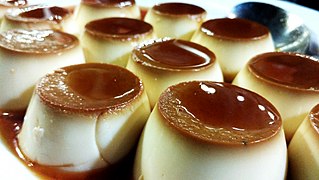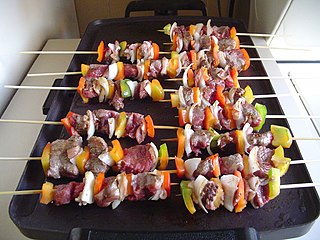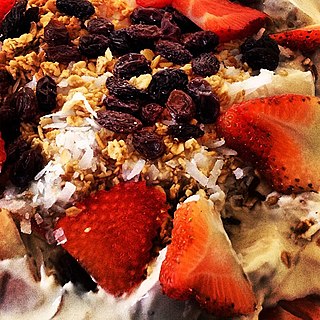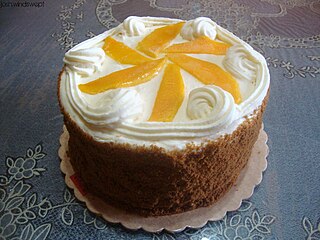Related Research Articles

Catalan cuisine is the cuisine from Catalonia. It may also refer to the shared cuisine of Northern Catalonia and Andorra, the second of which has a similar cuisine to that of the neighbouring Alt Urgell and Cerdanya comarques and which is often referred to as "Catalan mountain cuisine". It is considered a part of western Mediterranean cuisine.

Crème caramel, flan, caramel pudding, condensed milk pudding or caramel custard is a custard dessert with a layer of clear caramel sauce.

The ensaïmada is a pastry product from Mallorca, Balearic Islands, Spain, commonly found in southwestern Europe, Latin America and the Philippines.

Rajas con crema is the name given to a Mexican dish consisting of sliced poblano pepper with cream. It is very popular in Mexico, particularly in the central and southern parts of the country. It is one of the dishes most commonly served during taquizas, together with tinga, mole, chicharrón, and papas con chorizo. Preparation of the dish involves roasting, peeling and slicing the peppers, sauteing them together with sliced onions, and simmering the mixture with cream. Sometimes chicken broth is added for flavor.

Honduran cuisine is a fusion of Mesoamerican, Spanish, Caribbean and African cuisines. There are also dishes from the Garifuna people. Coconut and coconut milk are featured in both sweet and savory dishes. Regional specialties include sopa de caracol, fried fish, tamales, carne asada and baleadas. Other popular dishes include meat roasted with chismol and carne asada, chicken with rice and corn, and fried fish with pickled onions and jalapeños. In the coastal areas and the Bay Islands, seafood and some meats are prepared in many ways, including with coconut milk. Among the soups the Hondurans enjoy are bean soup, mondongo soup, seafood soups and beef soups. Generally all of these soups are mixed with plantains, yuca, and cabbage, and served with corn tortillas.

Pambazo is a Mexican dish or antojito made with pambazo bread dipped and fried in a red guajillo pepper sauce. It is traditionally filled with papas con chorizo or with papas only but there are different varieties.

Crème brûlée, also known as burnt cream or Trinity cream, and virtually identical to crema catalana, is a dessert consisting of a rich custard base topped with a layer of hardened caramelized sugar. It is normally served slightly chilled; the heat from the caramelizing process tends to warm the top of the custard, while leaving the center cool. The custard base is generally flavored with vanilla in French cuisine, but can have other flavorings. It is sometimes garnished with fruit.

Bionico is a popular Mexican dessert that originated in the city of Guadalajara in Jalisco, Mexico, in the early 1990s. It is essentially a fruit salad consisting of a variety of fruits chopped up into small cubes, drenched with crema and topped off with granola, shredded coconut, raisins and sometimes honey. Any kind of fruit can be used, but it is most commonly made with papaya, cantaloupe, honeydew, strawberries, apples and banana.

Plantain soup is eaten in various cuisines. In Colombian cuisine, the dish is known as sopa de patacón. There is also sopa de platanos in Latin American cuisine including Cuban cuisine and Puerto Rican cuisine.

Tortilla soup is a traditional Mexican soup containing fried corn tortilla. Although the exact origin of tortilla soup is unknown, it is known that it comes from the Mexico City area in Mexico. Traditional tortilla soup is made with chicken broth combined with roasted tomatoes, onion, garlic, chiles and tortillas, cut into strips and fried.
Salva cheese from Crema is a PDO table cow's milk cheese made with raw curd. It is a washed-rind cheese that undergoes a medium or long aging period.

Crema is the Spanish word for cream. In the United States, or in the English language, it is sometimes referred to as crema espesa, also referred to as crema fresca in Mexico. Crema fresca or crema espesa is a Mexican dairy product prepared with two ingredients, heavy cream and buttermilk. Salt and lime juice may also be used in its preparation. Crema's fat content can range between 18 and 36 percent. In Mexico, it is sold directly to consumers through ranches outside large cities, as well as being available in Mexican and Latin American grocery stores in the United States. Crema is used as a food topping, a condiment and as an ingredient in sauces. It is similar in texture and flavor to France's crème fraîche and sour cream.

Crema de fruta is a traditional Filipino fruitcake made with layers of sponge cake, sweet custard or whipped cream, gelatin or gulaman (agar), and various preserved or fresh fruits, including mangoes, pineapples, cherries, and strawberries. It is usually served during the Christmas season. It has multiple variations, ranging from changes in the fruits used to the addition of ingredients like jam, sago, condensed milk, and others.

Mango float or crema de mangga is a Filipino icebox cake dessert made with layers of ladyfingers (broas) or graham crackers, whipped cream, condensed milk, and ripe carabao mangoes. It is chilled for a few hours before serving, though it can also be frozen to give it an ice cream-like consistency. It is a modern variant of the traditional Filipino crema de fruta cake. It is also known by various other names like mango refrigerator cake, mango graham float, mango royale, and mango icebox cake, among others. Crema de mangga is another version that additionally uses custard and gulaman (agar) or gelatin, as in the original crema de fruta.

Ube cake is a traditional Filipino chiffon cake or sponge cake made with ube halaya. It is distinctively vividly purple in color, like most dishes made with ube in the Philippines.

Mango cake or mango chiffon cake, is a Filipino layered chiffon cake infused with ripe sweet Carabao mangoes. It is typically topped with mango cream frosting, fresh mango slices, or pureed mangoes in gulaman or gelatin. Other common toppings include cream, cream cheese, and chocolate. It also commonly sandwiches slices of mangoes between the layers. It is one of the most popular cake variants in the Philippines, where mangoes are abundant year-round. Commercial versions are also available in large bakery chains like Red Ribbon Bakeshop and Goldilocks Bakeshop, as well as individual recipes from restaurants, often with unique names. It is very similar to crema de mangga, except that mango cake uses layers of chiffon cake not broas or graham crackers. The two recipes can sometimes be combined, however.

Ube cheesecake, also known as purple yam cheesecake, is a Filipino cheesecake made with a base of crushed graham crackers and an upper layer of cream cheese and ube halaya. It can be prepared baked or simply refrigerated. Like other ube desserts in the Philippines, it is characteristically purple in color.
References
- ↑ Herbst, Sharon Tyler (1995). The Food Lover's Companion (2nd ed.). Barrons Educational Series. ISBN 9780812015201.